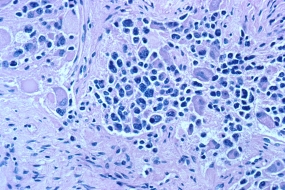Working Mechanism of Anticancer Drug Unraveled
A group of anticancer drugs known as HDAC inhibitors has shown effectiveness in preclinical trials against neuroblastoma, an aggressive type of cancer in children. Scientists from the German Cancer Research Center (DKFZ) and Heidelberg University Hospital have now found out that the drugs slow down tumor cell growth by promoting production of a cancer-inhibiting RNA molecule in tumor cells.
Neuroblastomas are pediatric tumors originating from cells of the embryonic nervous system. The disease can take extremely varying clinical courses, ranging from spontaneous regression to fatal outcome. The most aggressive tumors are characterized by up to 100-fold amplification of the MYCN oncogene.
For a couple of years now, clinicians have been fighting various cancers using substances inhibiting the activity of HDAC enzymes, or HDAC inhibitors. In the culture dish and in tumor-bearing mice, these drugs are also effective against neuroblastoma. Led by Dr. Hedwig Deubzer, a group of scientists from the German Cancer Research Center (Deutsches Krebsforschungszentrum, DKFZ) and Heidelberg University Hospital have studied the exact cellular structures of neuroblastoma cells affected by these drugs. “Only about 20 to 40 percent of high-risk neuroblastoma patients survive the disease in the long term. Therefore, we urgently need to find better treatments for this aggressive form of the disease. To increase the efficacy of drugs, it is extremely important to understand where exactly they work in the cell,” says Deubzer, a pediatrician.
The Heidelberg researchers investigated whether HDAC inhibitors have an impact on so-called microRNAs, small control molecules with manifold functions in the cell. The agent did in fact lead to significant changes in the microRNA profile. “In particular, the drugs increased the production of microRNA 183,” reports Dr. Marco Lodrini, first author of the article.
In order to find out whether microRNA 183 affects the malignant growth behavior of neuroblastoma, the researchers experimentally increased the production of this small RNA molecule in the cancer cells. The cells subsequently triggered programmed cell death, or apoptosis, and, in addition, no longer grew into tumors when transplanted into mice. “This corresponds to the effect we achieve with HDAC inhibitors,” Hedwig Deubzer explains.
There are 18 different HDAC enzymes present in every cell. Do they all have the same repressing effect on microRNA 183 production? To answer this question, the researchers systematically turned off the individual representatives of the HDAC family in neuroblastoma cells using molecular-biological methods and analyzed the effects on the production of microRNA 183. Blocking of HDAC2 alone achieved a similar effect as the drug, which turns off the whole enzyme family.
Hence, HDAC2 apparently plays an active part in suppressing the cancer-inhibiting microRNA 183, but it is not the only culprit. “Obviously, the MYCN oncogene and HDAC2 act together to block the switch of the gene for microRNA 183,” Deubzer explains. “But this result does not say that an inhibitor directed selectively against HDAC2 would be a better anticancer drug. The other members of the HDAC family may also contribute to the malignant behavior of neuroblastoma.” The department headed by Professor Olaf Witt at DKFZ has been working on the question of how HDAC enzymes promote cancer cell malignancy for several years.
Different members of the HDAC family appear to have very different impacts on the events involved in cancer. The Heidelberg pediatric oncologists led by Olaf Witt and Hedwig Deubzer are particularly interested in uncovering the exact working mechanism of HDAC inhibitors: For one year now, they have been studying in a clinical trial whether these drugs may help children with advanced cancers.
Marco Lodrini, Ina Oehme, Christina Schroeder, Till Milde, Marie C. Schier, Annette Kopp-Schneider, Johannes H. Schulte, Matthias Fischer, Katleen De Preter, Filip Pattyn, Mirco Castoldi, Martina U. Muckenthaler, Andreas E. Kulozik, Frank Westermann,Olaf Witt and Hedwig E. Deubzer: MYCN and HDAC2 cooperate to repress miR-183 signaling in neuroblastoma. Nucleic Acid Research 2013, DOI: 10.1093/nar/gkt346
With more than 3,000 employees, the German Cancer Research Center (Deutsches Krebsforschungszentrum, DKFZ) is Germany’s largest biomedical research institute. DKFZ scientists identify cancer risk factors, investigate how cancer progresses and develop new cancer prevention strategies. They are also developing new methods to diagnose tumors more precisely and treat cancer patients more successfully. The DKFZ's Cancer Information Service (KID) provides patients, interested citizens and experts with individual answers to questions relating to cancer.
To transfer promising approaches from cancer research to the clinic and thus improve the prognosis of cancer patients, the DKFZ cooperates with excellent research institutions and university hospitals throughout Germany:
The DKFZ is 90 percent financed by the Federal Ministry of Education and Research and 10 percent by the state of Baden-Württemberg. The DKFZ is a member of the Helmholtz Association of German Research Centers.


